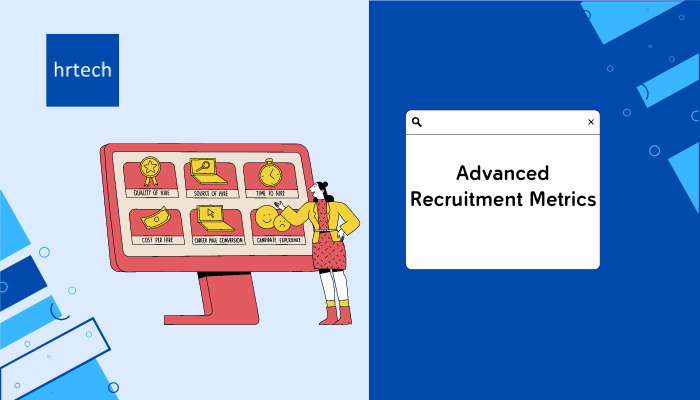A data-driven approach helps optimize the hiring process and track its success. This further enables a higher ROI for every dollar invested into the Talent Acquisition function.

1. What are Recruitment Metrics
Crucial to gauge the efficiency and effectiveness of an organization’s recruiting process, recruitment metrics account as a significant Key Performance Indicator (KPI) for the Talent Acquisition function. A data-driven approach helps optimize the hiring process and track its success. This further enables a higher ROI for every dollar invested into the Talent Acquisition function.
Some of the commonly used recruitment metrics such as time to hire, time to fill, source of hire, selection ratio, cost per hire, etc. help in the initial stages of a data-driven approach. However, as the TA function progresses in its data maturity curve, the TA teams must track some advanced recruitment metrics for better analysis and performance. This blog highlights these advanced recruitment metrics:
2. Recruitment Funnel Effectiveness:
Significance:
The entire recruitment process is positioned as a funnel. Fundamental stages of the funnel include application, screening, interviews, offers made, offers accepted, and eventually closed job positions. The funnel begins with sourcing and ends with the candidate onboarding. The journey through the recruitment funnel narrows down the talent pool until the most suitable candidate is selected.
Recruitment funnel effectiveness calculates the yield or the productivity at every stage of the funnel.
Formula:
Yield ratio = (# of applicants who successfully completed a stage) / (total # of applicants who entered the stage)
Let’s understand this with an example. Say 500 candidates applied for a junior engineer position at an organization. Of which 300 were shortlisted and moved ahead to the screening stage.
Thus, yield ratio of application stage = (300/500) = 0.6
3. Quality of Hire:
Significance:
Also referred to as QoH, this metric computes the value that a new hire brings to the organization and calculates their contribution to the overall business outcome.
QoH typically determines how worthwhile the recruiting process was. However, since quality is a subjective aspect, measuring it is difficult and should be done across a period of few months after the employee is onboarded. Organizations use various quantifiable metrics as indicators to determine the overall quality of the new hire. There are no standard indicators for determining the quality and they can vary according to business objectives.
A quality hire indicates better productivity, less turnover and a good culture fit. By continuously measuring the quality of hire, HR teams can understand the quality of the employee base, identify the gaps and work towards restructuring the processes accordingly.
Formula:
For example, assuming that as per organization’s leadership a qualitative hire is gauged by the following metrics:
- Engagement score
- Job performance score
- Ramp-up time score (the time a new hire takes to reach full productivity compared with the average time)
Quality of Hire = (% of new hires promoted + Job performance score + Ramp-up time score ) / # of indicators.
4. Candidate Net Promoter Score (NPS):
Candidate NPS measures the candidate experience with the organization’s recruitment process. It indicates how candidates perceive your hiring process and employer brand. Candidate NPS mirrors the most often used customer NPS metric for gauging customer loyalty and retention.
Candidates are surveyed on the following experience question: “On a scale of 0 to 10, how likely are you to recommend applying for a position here to a friend/family member?” Answers received are usually categorized into three groups:
- Candidates ranking between 0 and 6: Detractors
- Candidates ranking 7 & 8: Neutrals/ Passives
- Candidates ranking 9 & 10: Promoters
A higher candidate NPS score means a better outlook of candidate experience during interactions with the organizations. This, in turn, leads to a better employer brand and improved candidate conversion ratio. The score gives insights about where the organization currently stands in interacting with potential candidates and what further steps should be taken to improve these experiences.
Formula:
Candidate NPS = % of Promoters – % of Detractors
5. New Hire Attrition Rate:
Significance:
Also known as first year attrition rate, the metric calculates the number of employees who leave a job within their first year. The metric is crucial in determining the success of the hiring and onboarding process. Employees who leave in their first year of employment may not have become fully productive and hence impact the organization’s cost and productivity. Moreover, a higher new hire attrition rate usually damages recruitment budget, employer brand, and most importantly, the team morale.
Formula:
New hire attrition rate = # of new hires who left the organization within one year / # of new hires in last one year) * 100
6. Employee Referral Rate
Significance:
Employee referrals take place when your employees refer candidates for job opportunities at the organization. Employee referrals need to be the preferred method for hiring top talent. Referrals eliminate paying traditional recruiting costs like posting an opening on a job board, agency fees, etc and also indicate the employee satisfaction levels (as happy employees are always the best brand ambassadors).
According to a research by Jobvite, in terms of saving time, it takes 29 days on average to hire a referred candidate, compared to 39 days to hire a candidate through a job posting or 55 days to hire a candidate through a career site.
Formula:
Total # of referrals during a certain time period in comparison to a corresponding period in the past (OR) Total # of referrals per open job requisition in comparison to the industry average
In Conclusion:
The aforementioned recruitment metrics will aid the Talent Acquisition team in understanding the lapses in the ongoing recruitment processes and what should be the focus areas to fix those gaps. In order to ensure a shift from a mere headcount hiring to a strategic workforce hiring, abiding by these metrics is a starting point for any recruitment professional.




